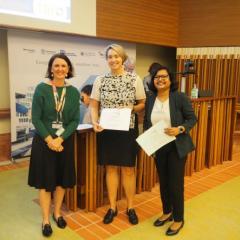By Mitchell Stark
Medical conference networking is critical to connect with global experts to form research collaborations.
But the coronavirus pandemic has brought large gatherings to a halt, causing concern for the impact on new research breakthroughs.
One such breakthrough was made after the ninth World Congress of Melanoma in October 2017. It was there that I met my now long-term collaborators from The Hospital Clínic de Barcelona in Spain.
Joan-Anton had just presented his group’s latest findings on the molecular analysis of giant congenital melanocytic naevi (CMN), and I was keen to explore this further.
These giant (greater than 20cm) “birthmarks” are present at birth and grow as a child grows.
Small to medium CMN are much more common, however those classified as large or giant cause great concern because they have an increased risk of malignant transformation to melanoma, and the most severe complication manifests as a melanoma of the central nervous system. Patients with these large and giant birthmarks need close monitoring by their doctor to look for signs of change.

Clinical images of Giant Congenital Melanocytic Nevi (CMN) patients with distinct molecular background.
Meeting Joan-Anton and his colleagues sparked a new collaborative effort that has since worked to find the causes of giant CMN.
Previously, the Spanish group found that about 60 per cent of giant CMN have a mutation in a gene called “NRAS.” Mutations in NRAS are well known to be involved the growth of the pigment-producing cells of our skin called melanocytes.
Our goal was to explore what other novel gene mutations drive the formation of giant naevi, for the remaining 40 per cent of these giant birthmarks.
In patients without NRAS mutations, we discovered two new genes (LFNG and TMEM2) harbouring mutations that occur at high frequency.
These findings are in their early stages, but it is highly suggestive that there is a causative relationship between these mutations and the development of giant congenital naevi, and that NRAS mutations are not the sole driver.
We also looked at “mutation signatures”. Different causes of mutations, such as UV light, cigarette smoke or pre-existing genetic defects, each cause unique patterns of mutation, leaving identifiable mutation signatures which have become integral to understanding the causes for somatic mutations.
We discovered that a mutation signature relating to defects in a DNA repair pathway was frequent, which suggests that this plays a role in the development of giant CMN.
These results confirm that environmental causes, like sun exposure, do not play a role in their development, and suggests there is an opportunity to clinically manage patients or identify early signs of malignant transformation.
This work also shows that bringing researchers from around the globe together can lead to exciting new developments that might not happen otherwise.
During this time of global disruption, we need to find new ways to connect with experts that can allow those ‘casual’ conversations that lead to impactful partnerships.

Dr Mitchell Stark is an Early Career Research Fellow from the University of Queensland Dermatology Research Centre. Dr Stark has actively been working towards understanding the aetiology of melanoma for more than 20 years; studying gene dysregulation during tumour progression along with predisposition to melanoma in families with high risk for melanoma development. His CMN research was published in Journal of Investigative Dermatology (DOI: 10.1016/j.jid.2020.07.022).



